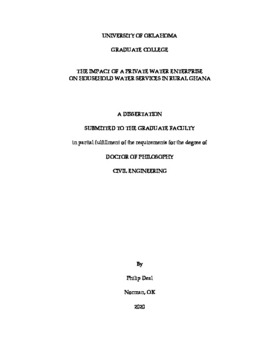| dc.description.abstract | The goal of this dissertation is to investigate the effectiveness and sustainability of a private water service delivery model in a rural, developing context. Recent studies have found evidence for greatly increased reliability and functionality rates, faster breakdown response times, and increased revenue for water systems managed by these novel service providers (Bey, V., Magara, P., & Abisa, 2014; Kayser et al., 2014; Koehler, Thomson, & Hope, 2015). In Chapter 1, we show how other historical paradigms have claimed improved water provision in the past, but various issues prevented government, public, community, and private providers alike from providing safe, continuous water supply in developing contexts. It is imperative that the service delivery approach be carefully evaluated to guard against similar challenges while identifying potential risks. This work will investigate Access Development (AD), a private service delivery model in Ghana. Results and discussions will use institutional, technical, financial, social, and environmental perspectives to craft a holistic understanding and assessment of this approach.
In a recent assessment by the World Bank (2017), the authors called for a better understanding of water facility performance, service level received, and performance of the rural water providers. In order to address this need, Chapter 2 evaluates the overall water service of a private safe water enterprise as compared to historical management systems in the rural, developing context of the Wassa East District. A quasi-experimental design used key informant surveys, household surveys, and water quality testing to investigate the service received by households under various management schemes. Service indicators were compared using logistic regression analysis. Given the nature of private providers and the pre-payment required, it can be hypothesized that overall, the district will benefit from improved service, but the quantity of water collected, and the penetration rates, will be lower for those in poor socioeconomic classes.
The results showed that AD Users received significantly improved water service as compared to non-users for the following indicators: water quality (fecal contamination, secondary disinfection), accessibility (distance), reliability (annual uptime), and acceptability (odor, appearance). No significant difference in service provision was observed for quantity, congestion, lather, and taste. However, Users received significantly lower scores in affordability and daily availability. Further, private customers were more reliant upon multiple water sources to meet domestic needs (p<0.05). Although there were slightly increasing trends, penetration (p = 0.43), water quantity collected from AD sources (p = 0.10), and the Joint-Monitoring Programme (JMP) service (p = 0.17) from AD water sources were not significantly affected by relative wealth. This evidence shows that both poor and rich households were being served by private kiosks under the current model.
The performance of a service delivery model will inherently affect its penetration rate, or the proportion of households within a given service area that purchase its water. It can be hypothesized that Access Development, acting as a communal water provider, will be unable to reach a penetration rate approaching 100% as long as existing competition is readily available. Chapter 3 discusses this phenomenon and its relationship to financial sustainability. A cross-sectional assessment of sixty rural communities was used to evaluate the market share of the private service provider. Household survey results for motivations, willingness-to-pay, and actual spending were used to develop a customer profile. Distance, taste, appearance, and affordability were found to be the most common motivational drivers. Using this information, a Huff gravity model was developed to assess the actual and potential market share for the company in each community. While the model and actual results agreed that about 39% of respondents would be regular customers at the given price, the attractiveness of other sources would make it difficult to capture more than 58% of the sampled households, even if water was free.
The hydrogeological setting is important in understanding the resource availability and limitations of the water service provider. Chapter 4 outlines the process of producing a manual drilling feasibility map for the Upper East Region of Ghana. This coincides with potential groundwater exploitation for the Precambrian Basement in West Africa. While regional siting techniques have been developed in the past, this type of assessment had not yet been conducted in Ghana (Danert, 2015; Fussi et al., 2017; Martínez-Santos et al., 2017). Variables of interest include well yield, static water depth, laterite thickness, depth to hard rock, water quality parameters, and the degree of weathering. Indicator kriging is proposed as an interpolation method that builds upon previous efforts to identify suitable zones for manual drilling, particularly in weathered crystalline basement aquifers. This approach allows for heterogeneity within weathering profiles and provides probability mapping of success for regional planning. Indicator kriging interpolations for depth to hard rock predicted binary variables with over 90% accuracy. The model predicts that drilling into highly weathered layers will often be necessary to reach the required depths for groundwater use, emphasizing the importance of percussion techniques in the Precambrian Basement. | en_US |

